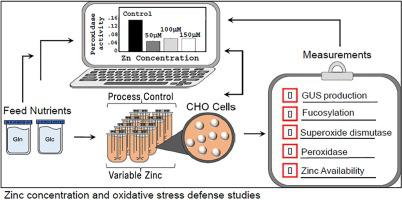Biochemical Engineering Journal ( IF 3.9 ) Pub Date : 2021-01-15 , DOI: 10.1016/j.bej.2021.107928 Ryan J. Graham , Stephanie A. Ketcham , Adil Mohammad , Evan Paregol , Seongkyu Yoon , Guozhang Zou , Tongzhong Ju , Patrick J. Faustino , Muhammad Ashraf , Chikkathur N. Madhavarao

|
Trace metal variation in culture media has the potential to affect CHO cell culture performance in an unpredictable manner. Previously, zinc variation in CHO cultures were shown to impact cell growth, viability, specific activity and apoptosis [1]. In mammalian cells, zinc deficiency is frequently tied to oxidative stress. Although recombinantly produced protein drugs are affected by oxidative stress, the relationship between cellular metal uptake and key oxidative stress defense mechanisms remains unclear in CHO cells. Here, we developed a strategy to assess the intracellular zinc and iron content of cultured CHO cells. Next, we supplemented a CHO cell line producing β-glucuronidase (GUS) with 0, 50, 100, or 150 μM zinc sulfate cultured in batch mode in spinner flasks and in fed-batch mode in parallel bioreactors. Zinc supplementation impact on GUS production was marginal (≤ 6%), but, impacted glycan fucosylation by decreasing up to ∼15 % compared to control cultures. Zinc depletion in the supplemented culture medium was as much as ∼20 μM under intense fed-batch cultures in parallel bioreactors. However, in less intense spinner flasks batch cultures zinc depletion was less profound at ∼2−5 μM over the course of the run. Intracellular zinc analysis showed that most zinc consumption occurs primarily during lag phase and minimal consumption thereafter. Harvest day analyses showed a five-fold increase in intracellular iron, higher peroxidase activity and lowered total superoxide dismutase activity in zinc-deficient control cells indicating enhanced oxidative stress defense activity correlated to zinc deficiency. Comparatively smaller impact on CHO culture performance in spinner flask cultures indicated a stronger need for zinc supplementation under intense cell culture conditions.
中文翻译:

补锌可调节CHO细胞培养物中细胞内金属的摄取和氧化应激防御机制
培养基中的痕量金属变异有可能以不可预测的方式影响CHO细胞的培养性能。以前,CHO培养物中锌的变化被证明会影响细胞的生长,活力,比活性和细胞凋亡[1]。在哺乳动物细胞中,锌缺乏症经常与氧化应激有关。尽管重组产生的蛋白质药物受氧化应激的影响,但在CHO细胞中细胞金属摄取与关键氧化应激防御机制之间的关系仍不清楚。在这里,我们开发了一种策略来评估培养的CHO细胞的细胞内锌和铁含量。接下来,我们向生产β-葡糖醛酸糖苷酶(GUS)的CHO细胞系添加了0、50、100或150μM硫酸锌,以分批方式在旋转瓶中培养,以分批补料模式在平行生物反应器中培养。补锌对GUS产量的影响很小(≤6%),但与对照培养物相比,通过降低约15%影响了聚糖岩藻糖基化。在平行生物反应器中,在强补料分批培养下,补充培养基中的锌耗竭量约为20μM。但是,在强度较低的旋转瓶中,分批培养的锌在整个运行过程中的耗竭程度约为2-3μM,而锌的消耗则较小。细胞内锌分析表明,大多数锌消耗主要发生在滞后阶段,此后最小。收获日的分析表明,缺锌对照细胞中细胞内铁增加了五倍,过氧化物酶活性更高,总超氧化物歧化酶活性降低,表明与缺锌相关的氧化应激防御活性增强。



























 京公网安备 11010802027423号
京公网安备 11010802027423号